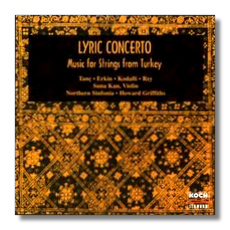
The Internet's Premier Classical Music Source
Related Links
- Latest Reviews
- More Reviews
-
By Composer
-
Collections
DVD & Blu-ray
Books
Concert Reviews
Articles/Interviews
Software
Audio
Search Amazon
Recommended Links
Site News
 CD Review
CD Review
Lyric Concerto

Music for Strings from Turkey
- Ulvi Cemal Erkin: Sinfonietta for Strings
- Cemal Resid Rey: Andante & Allegro for Violin & Strings
- Nevit Kodalli: Adagio for Strings
- Cengiz Tanç: Lyric Concerto for Flute, Oboe & Strings
Suna Kan, violin
Northern Sinfonia of England/Howard Griffiths
Koch Schwann 3-1480-2 DDD 58:02
I admit to knowing absolutely nothing about Turkish classical music before I started listening to this CD. Now that I have these four works under my belt, I can hardly refer to myself as an expert in the field, but I do know that I will be on the lookout for more collections like this one – it was well worth the several listens I gave it.
All of these composers received at least part of their musical training in Europe. Cemal Resid Rey, the oldest of the four, was born in 1904, and studied in Paris with pianist Marguerite Long and composer Gabriel Faurè. He returned to Turkey in 1923 and remained there until his death in 1885, working as a teacher and as a radio broadcaster. Ulvi Cemal Erkin (1906-1972) also studied in Paris, eventually with Nadia Boulanger. (Who didn't she teach?) He returned to Turkey in 1930 and made piano and composition his specialities. Nevit Kodalli (b. 1924) also studied with Boulanger, as well as with Honegger, before going home in 1953. Cengiz Tanç (b. 1933) is the odd man out: he went to London and the Guildhall School of Music. He and Kodalli have worked with Radio Ankara as "tonmeisters" – a word foisted upon the English-speaking world by Deutsche Grammophon, I believe.
These four works are written in a pleasantly modern idiom. Dissonance is used as a tangy flavoring, not as the central ingredient, and the music is easy to follow in terms of structure, melody, and harmony. Erkin's Sinfonietta is the most foreign sounding of the four. The third movement contains complex rhythmic divisions which the booklet notes lead us to believe are typically Turkish. The solo viola engages in some exotic melismas in this movement too. The first movement of Rey's Andante and Allegro is moody and a little dark – not unlike many other violin concertos from the 20th century. The mood brightens in the Allegro, and there are hints of dance-music, both European and Asian. Kodalli's brief Adagio is also mournful, and fans of Samuel Barber's Adagio for Strings will respond. (Actually, both works are arrangements from string quartet originals.) The last work on this CD is Tanç's substantial Lyric Concerto, which is built from episodes or "phases" chained together to form a 19-minute totality. Temperamentally, there is not much contrast between these phases, but Tanç uses scoring and timbre to distinguish them from one another. The music is intense and disquieting, and well worth exploring.
Although neither the Northern Sinfonia of England nor the soloist are gifted with the warmest of string tones, these performances seem quite good to me – Griffiths is a sympathetic conductor. These performers premièred the Lyric Concerto in Ankara in 1989. The booklet notes are informative, but the English – whether original or translated – is poor. The "tonmeister" and producer is Trygg Tryggvason, and the engineering is good. Although these recordings were made in 1994, this seems to be their first release in the United States.
Copyright © 2000, Raymond Tuttle


















